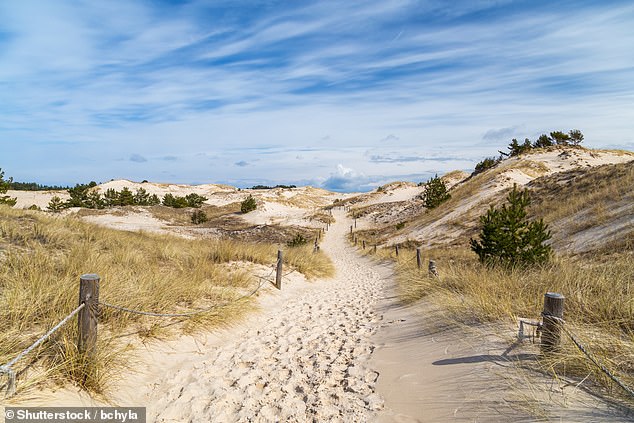So much of nature is just as ominous as it is beautiful.
And that’s definitely true of the sand dunes in Slowinski National Park, Poland.
Set along the country’s Baltic coastline, the 186.18 km2 (71.88 sq mi) park was created in 1967 to ‘preserve the beauty’ of the area’s lakes, peat bogs, meadows and woods, as well as ‘the most exceptional in Europe belt of moving dunes’, says Poland’s tourism board.
But these dunes are also the reason why so much of that scenery is no longer visible – especially along the park’s Mierzeja Lebska (Lebska Spit), where sand has been blown inland by the Baltic winds at an average rate of 10 metres (30ft) a year for thousands of years.
Where forests of tall trees once stood, there now sit mounds of sand as high as 40 metres (131 feet).
The only evidence these pines ever existed is the ‘fossilised tips’ poking through the top of some of the dunes, according to Atlas Obscura.

Set along Poland’s Baltic coastline, Slowinski National Park (pictured) was created in 1967 to ‘preserve the beauty’ of the area’s lakes, peat bogs, meadows and woods, as well as ‘the most exceptional in Europe belt of moving dunes’, says Poland’s tourism board

The Baltic’s winds have blown sand inland, along the park’s Mierzeja Lebska (Lebska Spit), pictured, at an average rate of 10 metres (30ft) a year for thousands of years

Where forests of tall trees once stood, there now sit mounds of sand as high as 40 metres (131 feet). The only evidence these pines ever existed is the ‘fossilised tips’ poking through the top of some of the dunes (pictured)
The travel company adds: ‘The native people of the area who have lived in the swamps and marshy woodlands near the dunes for hundreds of years claim that at least one entire village lies underneath the sand, a victim to the blowing winds and shifting soil.
‘Scientists agree that the three large lakes in the national park were once bays that were closed in by the tenacious movement of the dunes.’
In 1977, Slowinski’s everchanging terrain led to UNESCO designating it a World Biosphere Reserve, and it’s now home to many rare birds and aquatic birds, including white-tailed eagles and cormorants.
The national park has over 105 miles of hiking paths through the dunes.
There are also climbing observation towers dotted throughout the park, which ‘give even better vantage points’, says Poland’s tourism board.
If you’re planning a trip to Slowinski, the tourism board recommends staying in the nearby resort city of Leba, where horseback riding is offered ‘right on the sand for a memorable time in Poland’.

Atlas Obscura says: ‘The native people of the area who have lived in the swamps and marshy woodlands near the dunes for hundreds of years claim that at least one entire village lies underneath the sand, a victim to the blowing winds and shifting soil’

In 1977, Slowinski’s everchanging terrain led to UNESCO designating it a World Biosphere Reserve. The national park has over 105 miles of hiking paths through the dunes, as pictured. There are also climbing observation towers dotted throughout the park, which ‘give even better vantage points’, says Poland’s tourism board
This article was originally published by a www.dailymail.co.uk . Read the Original article here. .


